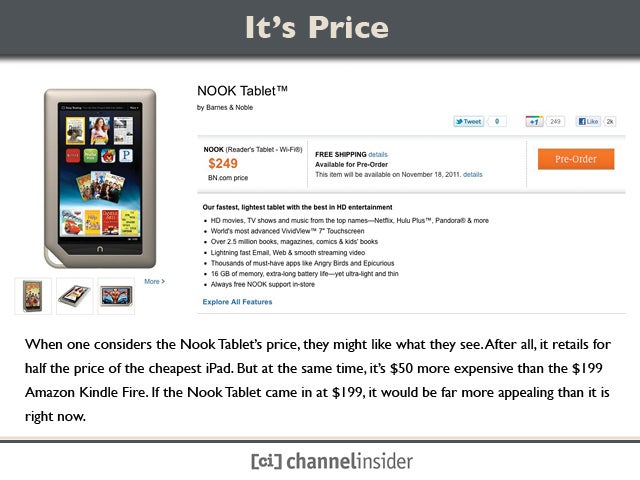 It’s Price
It’s Price
When one considers the Nook Tablet’s price, they might like what they see. After all, it retails for half the price of the cheapest iPad. But at the same time, it’s $50 more expensive than the $199 Amazon Kindle Fire. If the Nook Tablet came in at $199, it would be far more appealing than it is right now.
 Small Displays Aren’t Great
Small Displays Aren’t Great
There is a common misconception in the tablet space right now that smaller displays, like the 7-inch option in the Nook Tablet, are just fine. They’re not. Consumers use tablets to read books, watch movies, and surf the Web. That’s why bigger displays are better. Sorry, but the 7-inch display in the Nook Tablet is a disappointment.
 Integrated Services
Integrated Services
The nice thing about the Kindle Fire is that it comes with a host of integrated services from Amazon, including support for the company’s cloud storage, the Kindle e-book store, its MP3 marketplace, and more. The Nook Tablet supports Barnes & Noble’s e-book store, but beyond that, integration of services is not where it should be.
 The Design Is Boring
The Design Is Boring
Looking at the design of the Nook Tablet, there isn’t much to get excited about. The device comes with the standard tablet design, featuring a prominent display and small bezel around it. Other than that, it’s a run-of-the-mill tablet that in no way sets a new standard for how slates should look.
 The Enterprise Couldn’t Care Less
The Enterprise Couldn’t Care Less
If there is one customer group that really thinks the Nook Tablet is aloser, it’s the enterprise. The corporate world is looking for a device that has a big display, comes with useful enterprise features built-in, and doesn’t try to pander to consumers. Unfortunately, that’s exactly what the Nook Tablet does. And that alone makes it a less-than desirable option for the enterprise.
 Where’s the Differentiating Factor?
Where’s the Differentiating Factor?
One of the key success factors in the tablet space is having adifferentiating feature that makes other vendors look unappealing in comparison. The problem with the Nook Tablet is that it doesn’t have such a feature. It’s a 7-inch tablet with a $250 price tag running Android. We’ve seen that before.
 Mobile Network Support
Mobile Network Support
Those Nook Tablet owners that want to be able to connect to the Internet while away from a Wi-Fi signal will be out of luck. Unfortunately, because of its low price tag, the Nook Tablet doesn’t support 3G or 4G networks. Therefore, customers looking to go mobile with the tablet should look elsewhere.
 Android Has Yet to Prove Itself
Android Has Yet to Prove Itself
The Nook Tablet is running Android, an operating system that, while dominant in the smartphone market, is still far behind in the tablet space. Until Android can find a way to prove itself in the tablet market and make it clear to customers that it’s a worthwhile buy, the Nook Tablet just won’t look all that appealing.
 Where Are the Cameras?
Where Are the Cameras?
Looking around the tablet market, there are a host of companies — most notably, Apple — that are offering devices that feature both front- and rear-facing cameras. Those components have quickly become central to the success of slates. The only issue is, there are no cameras in the Nook Tablet, so customers hoping to snap a photo or hold a video chat are out of luck.
 The Kindle Fire Makes It Look Less Desirable
The Kindle Fire Makes It Look Less Desirable
Although the Nook Tablet and Kindle Fire are quite similar, with each of them offering the same display, Android, and many of the same features, Amazon’s option wins the day. The Kindle Fire is not only $50 cheaper, but as mentioned, it comes with a host of integrated Amazon services that make it quite appealing — and a better buy than the Kindle Fire.

